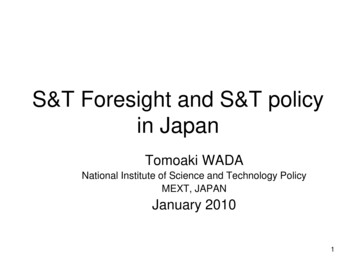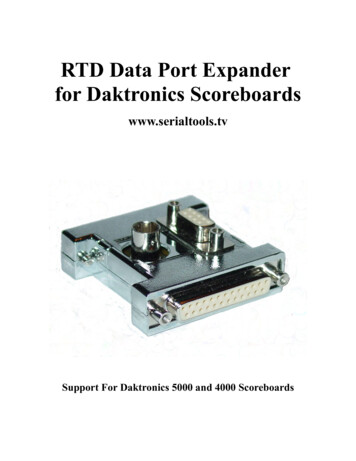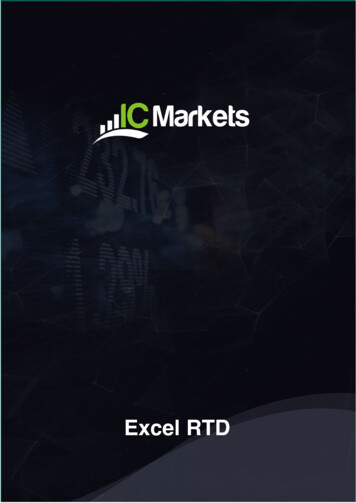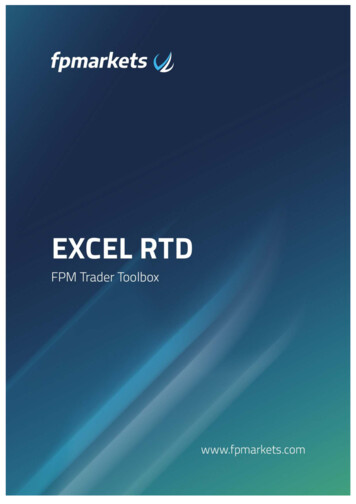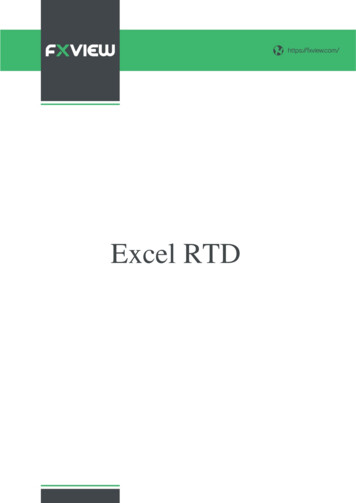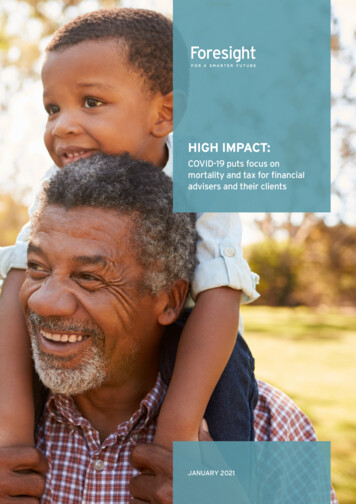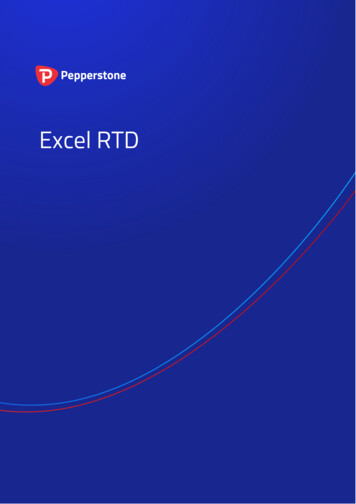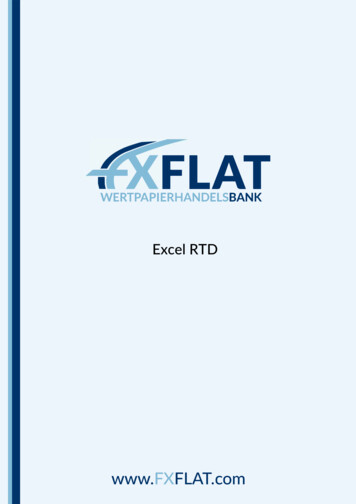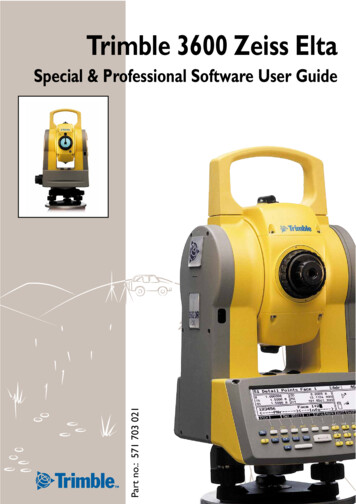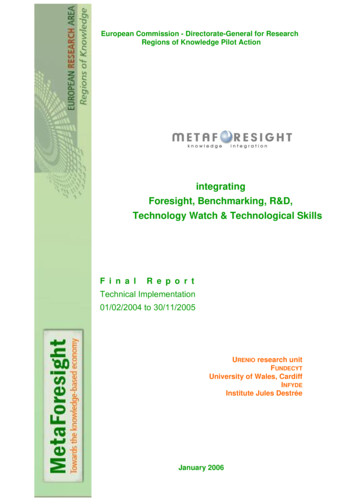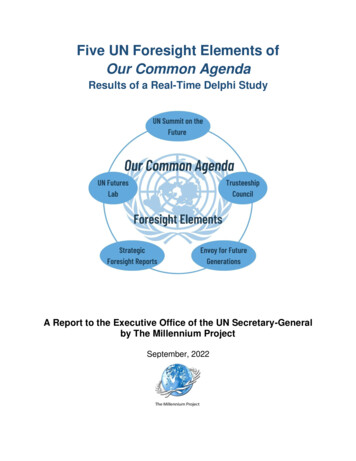
Transcription
Five UN Foresight Elements ofOur Common AgendaResults of a Real-Time Delphi StudyA Report to the Executive Office of the UN Secretary-Generalby The Millennium ProjectSeptember, 2022
TABLE OF CONTENTSIntroductionExecutive SummaryDistillation of responses for each foresight element1. UN Futures Lab2. UN Summit on the Future3. Strategic Foresight and Global Risk Reports4. Trusteeship Council repurposed as a Multi-stakeholderForesight Body5. Special Envoy for Future Generations6. Other Strategies important to considerAppendicesAppendix 1: Demographics of the participantsAppendix 2: List of participantsAppendix 3: The Real-Time Delphi Questionnaire
Page1INTRODUCTIONThe international foresight community overwhelmingly endorses and will support the fiveforesight elements of Our Common Agenda 1, as an integrated system, according to aReal-Time Delphi (RTD) study conducted by The Millennium Project. The panelincluded 189 professionals from 54 countries who provided 1,463 answers of which 983were explanations and comments. About half the panel had 20 or more years ofprofessional foresight or related experience. This study was conducted between May 9,2022 and July 1, 2022.The numeric responses to the RTD questionnaire called for judgment about thecriticality of each of the five foresight elements to improving global foresight. The resultsappear in Figure 1. The Executive Summary is a distillation and synthesis of thesuggestions and comments by the panel. The next section contains a more detailedlisting of the distillated comments organized by the three subquestions for each of thefive foresight elements: 1) how critical is the element to improving the effectiveness ofglobal foresight; 2) what and who would make this element successful and whatfeatures would make it most effective; and 3) additional thoughts or comments aboutthe element. This is followed by a distillation of other strategies participants thoughtimportant to consider when implementing Our Common Agenda’s recommendations forUN reform to improve global foresight.The RTD questionnaire used in The Millennium Project’s study is presented in theAppendix, along with the demographics and listing of the participants' names andcountries. The full, unedited text of all the comments is available l commoner1&q cat OCA1Figure 1. Foresight Elements of Our Common Agenda rated by the panel for criticalityin improving global nda-report/assets/pdf/Common Agenda Report English.pdfReal-Time Delphi Study on the UN Foresight Elements in Our Common Agenda The Millennium Project
Page2EXECUTIVE SUMMARYThe UN Futures Lab was rated the most critical element among the five for improvingglobal foresight by over half of the Real-Time Delphi panel. It is critical, urgent, andessential to do it as soon as possible. It is critical for all the other foresight elements inOur Common Agenda. The Lab should function across all UN agencies and integrate allUN data and intelligence, creating a global collective intelligence system. This wouldcreate an official space for systemic and systematic global futures research. It couldbecome the foresight brain of humanity, and put the future on the global governanceagenda. The Lab should be the UN focal point to analyze the hundreds of yearly reportson the future and different indexes and variables to keep track of progress of MemberStates. It can “connect the dots” of the many foresight studies, prioritize and synthasethe main conclusions, risks and opportunities, and high impact strategies. It can helpcountries develop their national foresight capacities and find synergies among nationalfutures lab-like units. This would be where the real work gets done, hopefully shieldedfrom political and bureaucratic influences.The UN system has lacked a high-level space for futures and foresight, which has led tofragmentation and lost learning. The lab can function as an online bank of futuresresearch and new ideas, which can feed the relevant actors including the other foresightelements in Our Common Agenda. The UNSG should be committed to hiringexperienced foresight professionals linked to related national and international efforts tosynergize the best futures intelligence. Futures research methodological rigor wouldkeep the subjectivity of analysis as low as possible. The Lab’s team should be transdisciplinary, inter-cultural, multi-sectoral, and grounded in sound science, futuresresearch methodology, and foresight practice. It could be a place where public andprivate foresight collaboration occurs.The Summit on the Future is an opportunity to put strategic foresight at the center ofmultilateral decision-making. It will improve global leaders’ foresight by connecting themwith futurists and their research. It should produce more long-term, systemic, andcoherent global strategies and gradually build a global consensus on how to build abetter future and stimulate a global culture of long-term thinking. Countries could sign apledge of agreement with the goals and objectives of Our Common Agenda and/or aUniversal Declaration on the Future and integrate these into their national long-termplans and budgets. Another product could be an action agenda for 2040 and 2050. TheSummit should have side events for creative thinking, gaming, simulations, anddiscussions to create futures and pathways independent from current patterns.Prior to the Summit, the UNSG could issue key results from foresight surveys and/orconduct a survey of global futures research to share with all governments. The High-Real-Time Delphi Study on the UN Foresight Elements in Our Common Agenda The Millennium Project
Page3Level Advisory Board should be part of the preparations for the Summit. Online andphysical national and regional pre-Summits could be conducted on critical future issues;insights from these meetings could be collated and studied prior to the Summit. Thereshould be an online foresight program to provide a framework for countries to thinkthrough a range of possible futures, threats and opportunities. A live and livelybroadcast could have futurist commentators for improved public understanding. Fewacted on futurists’ warnings of pandemics and global warming 50 years ago, and nowthe need to develop global governance of artificial general intelligence and syntheticbiology are being ignored; the summit could reduce such short-termism by includingfuturists in Summit delegations. This would be an opportunity for global media coverageof important future issues and opportunities leading to support for global action,implemented locally. Giving youth a voice at the Summit could be very powerful. TheSummit should be conducted biannually with follow-up mechanisms to hold countries totheir promises.Strategic Foresight and Global Risk Reports were seen as very critical for improvingglobal foresight by nearly 40% of the panel. This is exactly the kind of report that theUnited Nations should give the world. Along with its own analysis, these reports shouldprovide an analysis and synthesis of all the other major foresight and risk reports,provide roadmaps for global strategies, and give equal weight to risks and opportunities.The reports should be issued every one or two years due to accelerating change, andthe need to keep people involved with these issues. It should include a chapter onactions taken since the last report, with examples of risk mitigation, management, andwhat persists. A State of the Future Risk Index could be a key feature of these reports.They should bring attention to threats that are often ignored with cost estimates forprevention vs. recovery (Bill Gates estimates it will cost 1 billion to address the nextpandemic comparted to the 15 trillion spent on Covid so far). It should identify timesensitive information required to make more intelligent decisions.The report should also be updated online in real-time due to unforeseen incidents (wars,pandemics, research breakthroughs, new discoveries, etc.). Many people are morewilling to watch than to read; hence, the reports should be issued in several formatsincluding, audio, film/video, podcasts, virtual reality, online real-time dashboards, andinteractive AI simulations, adapted for the youngest to the oldest, from the most trainedto the least trained. These reports would be especially helpful for those countries that donot have their own futures research and foresight analysis capacity. Since attention toshort-term risks usually overrules long-tern existential risks, a separate UN office ofexistential risks should be established to provide input to this report. It should Include asection and/or dashboard on the status of the 12 commitments in Our CommonAgenda.Real-Time Delphi Study on the UN Foresight Elements in Our Common Agenda The Millennium Project
Page4Trusteeship Council as a Multi-Stakeholder Foresight Body will require a change tothe UN Charter and UNGA agreement, but worth the effort, as this is the most importantUN structural reform for foresight and participation by more than just governments. TheCouncil should be the permanent arm of the Summit on the Future to enforce actionbetween events, and negotiate with governments on subjects of the future. Membersshould be rotated so that the Council doesn’t become a small group of elites. TheCouncil needs decisionmaking authority and incentives for key stakeholders toparticipate. Long-term management of global public goods, facilities, and risks requiresmulti-stakeholder guidance. Multi-stakeholder systems generate more objective results,promotes trust among various groups, and thus is likely to be more effective than aCouncil based only on geographic political representation, since governments are nolonger the only actor in world affairs.Since it will be difficult to get all the multi-stakeholders in the hall at the same time, theCouncil could function as a hybrid system (physical, streaming, Metaverse, bothsynchronously and asynchronously); hence, it could have many sub-elements usingsoftware to collect, assess, and recommend actions: some actions for governments,some for businesses, some for academia (universities and think tanks), and some forNGOs. The UNSG could request IT leaders to make this new Council a model ofmodern decisionmaking support software and/or collective intelligence software. Youngpeople in the Council could use social media to involve youth worldwide. Free exchangeaway from publicity may be more helpful than summits; the Finnish ParliamentaryCommittee for the Future is an example. The Council should authorize foresight studiesand its members should have adequate foresight competency.Special Envoy for Future Generations would signal that long-term thinking, and intergenerational solidarity is taken seriously. The Office of the Envoy could serve as anumbrella for the many youth organizations worldwide. There should be metrics fortracking intergenerational equity in all UN activities. The Envoy should be invited toparticipate in all UN activities and be able to challenge all UN agencies to take severalfuture generations into account in their programs. The Envoy should draw on researchon intergenerational fairness and justice, and use the example of the FutureGenerations Commissioner of the Government of Wales. Consider replicating the ideaof special envoys in every country, and incorporating young ambassadors from eachcountry helping to integrate national Future Labs and the re-purposed TrusteeshipCouncil. The office needs to be well-staffed and financed, to be effective.The Office of the Envoy should develop indices for measuring opportunities forchildren/youths and identify/synthesize best practices, national youth policies, andmodels (e.g., Wales; UNCRC). The Envoy should disseminate information to educationsystems worldwide, and help integrate futures thinking in curricula. The Envoy shouldbe a big media personality, recognizable to and respected by young people toReal-Time Delphi Study on the UN Foresight Elements in Our Common Agenda The Millennium Project
Page5strengthen the principle of intergenerational equity. There is a risk in having only oneperson; instead, consider the Envoy as a team, including the UN SG when he retires,and/or a person from each continent, working together as a team, even including atrusted Artificial Intelligence. This could be enhanced with the incorporation of UNgoodwill ambassadors.Other strategies are important to consider. The UN should ‘lead by example’integrating foresight methods in all its units. Consider establishing regional UN officesfor future studies as the UN has for economics (UNECA, UNECE, UNECLA, etc.).Futures Ambassadors to each Member State might be created. A State of the FutureIndex with multidimensional indices as an alternative to GDP could be part of thisinitiative. Establish an annual Futures Studies prize like a Nobel Prize. A Futures Corpsmight function as part of, or separate from UN Volunteers that is designed to focus onfuture issues and opportunities.Consider establishing an UN Office of Existential Risks to long-term human survival. Itcould include a national threats index with levels of resiliency and required levels ofpreparation in order to set priorities and timing of decisions and actions. Revise theUniversal Declaration of Human Rights to take into account the opportunities andthreats from new technologies, including what are known as “transhuman rights”.Establish a UN Future Compact (similar to the Global Compact) of cutting-edgeexpertise to deliver compliance reports every two years managed by a CooperationOffice for the Future accountable to the UNSG and delivers reports to the UN GeneralAssembly. Map all UN activities as a basis for a dynamic, iterative improvement processusing SMART goals (Specific, Measurable, Ambitious but Achievable, Resourced andTime-based). Continually crowd-source for a dynamic model of the future of society andalso give attention to opportunities, not just risks.Real-Time Delphi Study on the UN Foresight Elements in Our Common Agenda The Millennium Project
Page6DISTILLATION OF RESPONSES FOR EACH FORESIGHT ELEMENTThis section contains a distillation of the inputs received from the participants for eachelement, organized by the respective sub-questions. The full, unedited text of all thecontributions received is available online l commoner1&q cat OCA11. UN Futures LabFigure 2. Ratings of criticality of a UN Futures Lab to improving the effectiveness ofglobal foresight1.1 Explanations and comments on how critical a UN Futures Lab is to improvingthe effectiveness of global foresight: It could put the future on the global governance agenda.Gives a focal point for collecting global futures research and assessing strategiesto improve the prospects for humanity.This would be where the real work gets done, hopefully shielded from politicaland bureaucratic influences for as long and as much as possible.A UN Futures Lab is critical to all of the other foresight elements in Our CommonAgenda.It is not only critical; it is urgent and essential to do it as soon as possible.It creates an official space for systemic and systematic global futures researchusing methods and with the participation by professional futurists.Real-Time Delphi Study on the UN Foresight Elements in Our Common Agenda The Millennium Project
Page 7The UN system has lacked a high-level space for futures and foresight, whichhas led to fragmentation and lost learning. The lab could serve all agencies anddrive further engagement across the entire UN system.Having UN and national officials participating in the Futures Lab will increasetheir capacity for long-range thinking.It could be the center for analytic models that are used in forecasting; it couldevaluate and distribute hard data on which such models may depend. But becareful: this might result in a “not invented here” syndrome; so, registering amodel as official or acceptable like a seal of approval, could constrain thinking.This initiative could help to: a) analyze hundreds of yearly reports on the futureand extract and prioritize the main conclusions, risks and opportunities; b)deepen understanding of specific issues; and c) help countries to develop theirnational foresight capacities.Top-down (decisionmakers and policy makers, governance) and bottom-up(society, economy, academia) need to meet here and experiment together.This is very critical but absolutely dependent on its ability to conduct rigorous,defensible and compelling work that has the respect of the broader UN community.This depends largely on the commitment and ability to recruit highly skilled futuresresearchers and foresight practitioners.If it is truly a lab, then it should be grounded in sound science and practice.Could be a platform for many new technologies, tech assessments, and newsolutions.It should build international comparative set of indices/variables to track progressin each country connected to an interactive, web-based, publicly accessibledatabase of what works to improve each indicator from both public and privatesectors.Function across all UN agencies while integrating all UN agencies’ data makingaccess without having to convert all the myriad IT systems of numerous UN andother global and national and local organizations to be compatible, becoming thebasis for global collective intelligence system on the future.The global issues that we currently face can only be addressed through acollective intelligence system involving a wide range of international andprofessional bodies, transnational organizations and diplomatic channels.This may have the similar function as UN Office on Strategic Threatsrecommended by MP and other organizations. It could be the largest laboratoryfor the future survival and development of humanity.Participants should be a diverse set of individuals—demographically,ideologically, politically, etc. This cannot be another forum for groupthink oragenda-driven bickering. If the people assigned to this lab can research, think, beopen minded, and be willing to LISTEN to other points of view, this could be ahuge success. But if this becomes another echo chamber of the prevailingnarrative, it will be another useless appendage that will be ridiculed and mocked.Explore how the Futures Lab could work with the other foresight elements andfunction across all UN organizations, becoming a global collective intelligencesystem.Real-Time Delphi Study on the UN Foresight Elements in Our Common Agenda The Millennium Project
Page 8The Lab should be independent; if the Internet Engineering Task Force wasunder the auspices of the UN or the ITU, we wouldn't have the miraculousconnectivity and global knowledge graph we have built today.There is a risk that the Council and the Lab will chart competing paths.Futures research methodological rigor will keep the subjectivity of analysis as lowas possible.It can work as the main hub to synergize, increase value and amplify theimportance of futures work around the world.Develop methods for futures solutions prototyping using UN databases tovisualize and experience data in multiple forms.UN Future Lab could be distributed (i.e., not just having one location) across theglobe.Don't let the lab become a mediocre recycler of ideas about incremental change.1.2 Explanations and comments on what and who will make this successful. Whatfeatures would make the UN Futures Lab most effective? Create or debate about creating an integrated planetary index which collects allthe different indexes in order to rank countries based on their contribution toGood Planetary Governance.Build a collective intelligence system of new ideas, research, and projects toimprove humanity, which can feed to the relevant actors.Be a laboratory based on collective intelligence and collaboration, the hub of agreat neural network of theoretical and practical knowledge that serves publicpolicies for the common good for humanity.Recruit highly skilled futures researchers and foresight practitioners interested inthe common good.Learn from and hire internal team with experience of integrating foresightmethods in institutions, and communicating practical results.Deliver insights to decision-makers in powerful new formats (e.g., interactiveVR/AR simulations and models).Be an integrated, systematic learning loop for continual improvement.Be a space where any UN staff can go to secure resources and support to integratefutures and foresight into any project and/or program.Should collect and catalog scenarios.Work with the other foresight elements feeding foresight intelligence andconvene and coordinate its own global meetings.Prepare versions of futures labs that can be carried out in secondary education,that allow the participation of youth in initiatives.Mobilize a wide network/community of futures labs across the world, findsynergies, and play a key role in the further development of that community.Organize worldwide hackathons to involve young voices to participate usinginnovative technology like AI, VR/AR/MR to be immersive.Real-Time Delphi Study on the UN Foresight Elements in Our Common Agenda The Millennium Project
Page 9Focus on quick wins, i.e.; clearly defined first tasks and deliverables early-on thatprovides proof of concept.Make the team trans-disciplinary, inter-cultural, multi-sectoral, and a place wherepublic and private foresight collaboration occurs (a major weakness of theMillennium Development Goals was the failure to reach out to the private sector).Use AI and experts in data analytics and combine vast amounts of structured andunstructured information in new ways that delivers it’s work to decision-makers inpowerful new formats and timeframes.Make big societal shifts comprehensible and accessible for everybody.Include those future issues not addressed elsewhere.Use immersive techniques, AI and ML to create simulations of all sorts ofsubjects; maybe Google, Oracle, MIT, etc. could help as long as their algorithmsare neutral.Involve the poorest village and the richest; involve illiterate people and postdocs.Function as an online bank of forward-looking thoughts and ideas.Use futures intelligence networks that already exist to connect specialists,experts, entities that work on these issues and the countries that need thissupport instead of creating a new UN body.1.3 Other Strategies and additional thoughts: Key functions of the lab should be to identify emerging issues that have thepotential to become important risks and threats but are not (yet) worthy of aresponse and sustain a global conversation on the need to identify and track theevolution of such issues.The problems addressed in this lab could be rated for significance to establishpriority, including consideration of the number of people likely to be affected,imminence (time available to invent a solution), public awareness of need to act,funding, etc.Make it the foresight brain of humanity with special attention to new andinnovative ideas and successful projects. It should identify future-critical issues,like how to govern the transition from artificial narrow intelligence to artificialgeneral intelligence.Involve the World Economic Forum and financial agencies like Black Rock.Balance attention to both global and regional patterns of change.Build futures capacities, long-termism, best foresight practices, forward actionsand adaptability for states, subnational authorities, and others. It might be helpfulto examine what directed the establishment of the International Space Station(e.g., principles, governance, processes) and how disagreements (if any) havebeen resolved in that challenging instance.Promote futures literacy among citizens and the public at large.Output of this unit must be professional foresight, built on research, not politicalviews or thoughts.Real-Time Delphi Study on the UN Foresight Elements in Our Common Agenda The Millennium Project
Page 10 Gather the main futurists from all continents in a Summit to present risk studiesand facilitate sessions with UN officers.Include how culture may evolve, in the context of climate change, longevity, AI,etc.; culture is ignored in foresight and cultural practitioners ignore foresight.Conduct research and publish futures research methodologies.A multi-year, if not decade-long, commitment to fund the Lab is essential.Figure 3. Interdependency of the five foresight elements of Our Common Agenda.Real-Time Delphi Study on the UN Foresight Elements in Our Common Agenda The Millennium Project
Page 112. UN Summit on the FutureFigure 4. Ratings of criticality of the UN Summit on the Future to improving theeffectiveness of global foresight2.1 Explanations and comments on how critical the UN Summit on the Future is toimproving the effectiveness of global foresight: The Summit is an opportunity to put strategic foresight at the center ofmultilateral decision-making. It should be a multi-stakeholders Summit: States(Governments and Parliaments), NGOs, networks of business and labor,universities, scientists, and think tanks.The Summit could stimulate a global culture of long-term thinking, and provide aframework for countries to explore the future.Pre-Summit planning could play a crucial role in connecting decisionmakers andfuturists through online interactions resulting in strategic foresight content, ratherthan a series of uplifting speeches.The Summit provides an opportunity for each nation to record its role in achievinga desirable future; these views could be analyzed and synthesized for a report bythe Office of the UNSG for a “state of national thinking about the future,” whichcould then become a focus or benchmark for improvement.If there is serious preparation and involvement of key countries, it could be acatalyst for raising interest and putting policies into action.The UNSG should call for specific and joint actions; the agenda should be clearand precise to allow concrete results to be obtained.Real-Time Delphi Study on the UN Foresight Elements in Our Common Agenda The Millennium Project
Page 12 Could get policymakers familiar with futures research, to think long-term,systemically, and coherently about global strategies.Would help to build a global consensus that transcends geopoliticalcontradictions, ideological and cultural gaps, and build a common, permanentand peaceful future.Global consensus on how to govern global public goods is crucial and urgent.Could change development models of leaders.Consider biannual Summits on the Future, not just one.The optics of the Summit are as important as the content, and may lead tofinancial commitments.One product could be a Universal Declaration of the Future.Opportunity for global media coverage of important future issues that increaseglobal awareness of actions to be implemented locally.2.2 Explanations and comments on what and who will make this successful. Whatfeatures would make the UN Summit on The Future most effective? Decisionmakers, not just representatives should participate.Giving youth a voice at the Summit could be very powerful.Make sure the goals and objectives are very clear.A set of moonshot pledges on future issues similar to SDGs/MDGs should becollected prior to the summit.Use live broadcast of the Summit with commentators and futurists who interpretwhat is happening as in the Olympics to the global public.Prior to the Summit, the UNSG could issue some key results from this Real-TimeDelphi, and conduct another RTDelphi as a part of the preparatory phase foractions to be considered at the Summit.Because of the magnitude of this, it might require regional, preliminary meetingswith the participation of experts in future studies, scientists, academics, NGOsand journalists that culminates in the global summit.Prior to the meeting, work on document(s) of commitments, in such a way thatwhat was previously agreed is supported.Provide all countries with a multidimensional business-as-usual forecast ofclimate change, human rights, peace and security with concrete measures totrack the forecasts.In addition to policymakers, the participants in both the preparation and theSummit should be diverse as possible, with special attention to includingprofessional futurists.The Summit should be organized in a co-creative and interactive way. Brief talksby different futures research leaders would feed ideas and inspiration for acommon discussion and elaboration by the participants.Let viewers submit questions and suggestions before and during the Summitusing interactive platforms.Real-Time Delphi Study on the UN Foresight Elements in Our Common Agenda The Millennium Project
Page 13 Summit should be related to a permanent UN collective intelligence process topromote knowledge co-creation, and broad and rich interactions.The Summit needs side events for creative thinking, gaming and discussion tocreate alternative futures.[already said above]Create a global participatory platform for early signals, shortbriefs and videos by governments and citizens to facilitate post Summit actionsand accountability.Countries should agree to the goals and objectives of Our Common Agenda andintegrate them into their national long-term plans and budgets.Promote the creation of Future Units in all countries that could manage andenhance deliberations within governments and civil society organizations.Summit could rotate among continents, not always at the UN in NYC, but movingyearly to other UN headquarters in Africa, Asia, Europe, etc.The next UN General Assembly after the Summit should have all governmentspresent their commitment to the future and sign a Universal Declaration of theFuture.2.3 Other Strategies and additional thoughts:
The international foresight community overwhelmingly endorses and will support the five foresight elements of Our Common Agenda1, as an integrated system, according to a Real-Time Delphi (RTD) study conducted by The Millennium Project. The panel included 189 professionals from 54 countries who provided 1,463 answers of which 983
